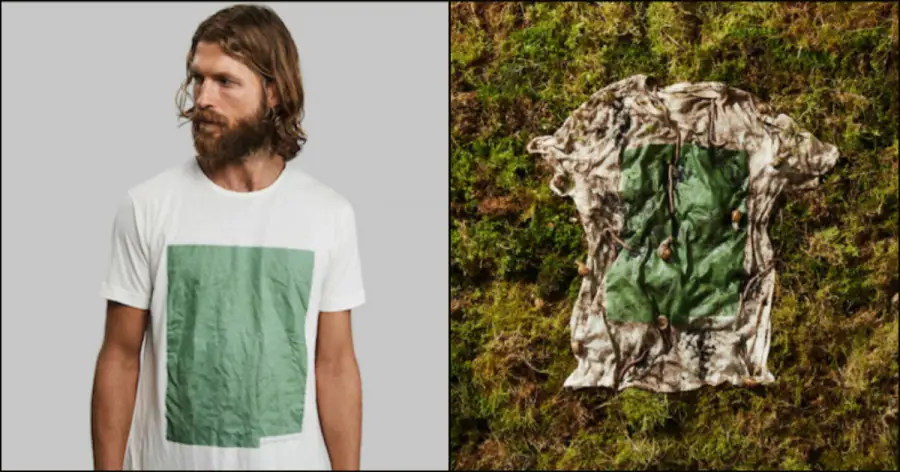One-Of-A-Kind Tee-Shirt Made From Wood And Algae Can Be Composted In Your Backyard

By Mandy Froelich / Truth Theory
Fast fashion is one of the greatest burdens on the modern world. For this reason, some innovators are developing compostable clothing. London-based tech startup Vollebak, for example, has designed the Plant and Algae T-Shirt which can be buried and composted in your own backyard.
The eco-friendly t-shirt is made of sustainably sourced eucalyptus, beech, and spruce trees. As the Vollebak website explains, the trees are chipped, pulped and put into textile yarn. The ink is made entirely from algae that the designers grew in a bioreactor.
“Instead of passing lake water through a cotton net, we pass water from the bioreactor through a filter,” says the company. “This process separates the algae, leaving a soupy algae paste. This paste is then dried in the sun to create a fine powder, and this powder is mixed with a water-based binder to make algae ink.”
Because algae can’t survive out of water, it turns into a natural pigment which fades to different colors over time. As a result, Vollebak designers can ensure no two shirts end up looking the same after they’ve gone through multiple washes.
“The Plant and Algae T-Shirt feels like a normal t-shirt when you wear it. It’s not going to start biodegrading if you go for a run or hang it up to dry,” says Vollebak.
Don’t worry about the garment falling apart, as the algae and wood tee must be buried in the ground to decompose. In just 8 to 12 weeks, the tee will be no more. “It’ll only start to biodegrade when you bury it in the ground or put it in the compost. It needs the fungus, bacteria and heat from the Earth to start to break down. If you want it to biodegrade, you have to bury it in the ground,” says the company.
Over 5000 people have downloaded our free ebook “Growth Hacking Tips And Rituals For Optimal Living” CLICK HERE to get your free copy now
According to a report by the EPA, approximately 10.5 million tons of textiles were sent to landfills in 2015, amounting to roughly 7.6% of total landfill waste. Other sustainability reports claim that it can take anywhere from 25 to 40 gallons of water to dye just two pounds of fabric. Every year, that amounts to a whopping 25 trillion gallons of water.
What Vollebak is proving is that clothing can be fashionable and eco-friendly. Now that eco-friendly attire options exist, it is the consumer’s responsibility to spend the extra dollar for a product that won’t place even further burden on generations to come. At $110 a shirt, this isn’t an easy feat. However, the clothing could spark an entirely new generation of eco-friendly clothing, and that’s exciting.
“The wood is turned into fabric using an environmentally-responsible and closed-loop production process,” says the website. “In practice this means that over 99% of the water and solvent used to turn pulp into fibre is recycled and reused. And on the Higg MSI scoring system—which measures the impact of producing a kilogram of fibre taking into account fossil resource depletion, water scarcity, eutrophication and global warming—this fabric scores 10 against cotton’s score of 60. Our eventual aim is to score 0.”
What are your thoughts? Please comment below and share this news!
h/t GoodNewsNetwork
Image credit: Vollebak
Leave Comment: